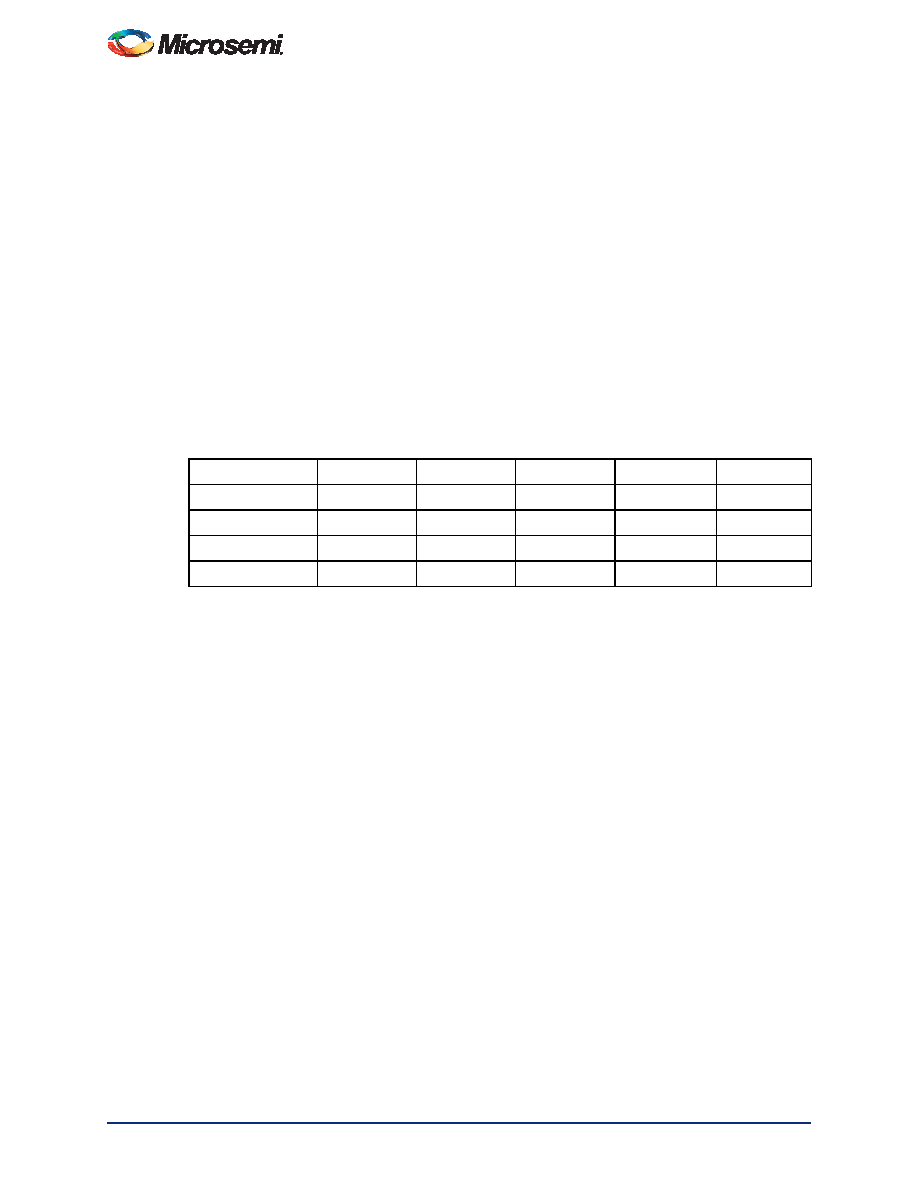参数资料
| 型号: | A1440A-TQ176C |
| 厂商: | Microsemi SoC |
| 文件页数: | 21/90页 |
| 文件大小: | 0K |
| 描述: | IC FPGA 4K GATES 176-TQFP |
| 产品变化通告: | A1440A Family Discontinuation 24/Jan/2012 |
| 标准包装: | 40 |
| 系列: | ACT™ 3 |
| LAB/CLB数: | 564 |
| 输入/输出数: | 140 |
| 门数: | 4000 |
| 电源电压: | 4.5 V ~ 5.5 V |
| 安装类型: | 表面贴装 |
| 工作温度: | 0°C ~ 70°C |
| 封装/外壳: | 176-LQFP |
| 供应商设备封装: | 176-TQFP(24x24) |
第1页第2页第3页第4页第5页第6页第7页第8页第9页第10页第11页第12页第13页第14页第15页第16页第17页第18页第19页第20页当前第21页第22页第23页第24页第25页第26页第27页第28页第29页第30页第31页第32页第33页第34页第35页第36页第37页第38页第39页第40页第41页第42页第43页第44页第45页第46页第47页第48页第49页第50页第51页第52页第53页第54页第55页第56页第57页第58页第59页第60页第61页第62页第63页第64页第65页第66页第67页第68页第69页第70页第71页第72页第73页第74页第75页第76页第77页第78页第79页第80页第81页第82页第83页第84页第85页第86页第87页第88页第89页第90页

Detailed Specifications
2- 20
R e visio n 3
Tightest Delay Distributions
Propagation delay between logic modules depends on the resistive and capacitive loading of the routing
tracks, the interconnect elements, and the module inputs being driven. Propagation delay increases as
the length of routing tracks, the number of interconnect elements, or the number of inputs increases.
From a design perspective, the propagation delay can be statistically correlated or modeled by the fanout
(number of loads) driven by a module. Higher fanout usually requires some paths to have longer lengths
of routing track. The ACT 3 family delivers the tightest fanout delay distribution of any FPGA. This tight
distribution is achieved in two ways: by decreasing the delay of the interconnect elements and by
decreasing the number of interconnect elements per path.
Microsemi’s patented PLICE antifuse offers a very low resistive/capacitive interconnect. The ACT 3
family’s antifuses, fabricated in 0.8 micron m lithography, offer nominal levels of 200
Ω resistance and 6
femtofarad (fF) capacitance per antifuse. The ACT 3 fanout distribution is also tighter than alternative
devices due to the low number of antifuses required per interconnect path. The ACT 3 family’s
proprietary architecture limits the number of antifuses per path to only four, with 90% of interconnects
using only two antifuses.
The ACT 3 family’s tight fanout delay distribution offers an FPGA design environment in which fanout can
be traded for the increased performance of reduced logic level designs. This also simplifies performance
estimates when designing with ACT 3 devices.
Timing Characteristics
Timing characteristics for ACT 3 devices fall into three categories: family dependent, device dependent,
and design dependent. The input and output buffer characteristics are common to all ACT 3 family
members. Internal routing delays are device dependent. Design dependency means actual delays are
not determined until after placement and routing of the user’s design is complete. Delay values may then
be determined by using the ALS Timer utility or performing simulation with post-layout delays.
Critical Nets and Typical Nets
Propagation delays are expressed only for typical nets, which are used for initial design performance
evaluation. Critical net delays can then be applied to the most time-critical paths. Critical nets are
determined by net property assignment prior to placement and routing. Up to 6% of the nets in a design
may be designated as critical, while 90% of the nets in a design are typical.
Long Tracks
Some nets in the design use long tracks. Long tracks are special routing resources that span multiple
rows, columns, or modules. Long tracks employ three and sometimes four antifuse connections. This
increases capacitance and resistance, result ng in longer net delays for macros connected to long tracks.
Typically up to 6% of nets in a fully utilized device require long tracks. Long tracks contribute
approximately 4 ns to 14 ns delay. This additional delay is represented statistically in higher fanout
(FO = 8) routing delays in the datasheet specifications section.
Table 2-14 Logic Module and Routing Delay by Fanout (ns); Worst-Case Commercial Conditions
Speed Grade
FO = 1
FO = 2
FO = 3
FO = 4
FO = 8
ACT 3 –3
2.9
3.2
3.4
3.7
4.8
ACT 3 –2
3.3
3.7
3.9
4.2
5.5
ACT 3 –1
3.7
4.2
4.4
4.8
6.2
ACT 3 STD
4.3
4.8
5.1
5.5
7.2
Notes:
1. Obtained by added tRD(x=FO) to tPD from the Logic Module Timing Characteristics Tables found in this
datasheet.
2. The –2 and –3 speed grades have been discontinued. Refer to
相关PDF资料 |
PDF描述 |
|---|---|
| A14V40A-TQG176C | IC FPGA 4K GATES 3.3V 176-TQFP |
| A1425A-PQG160C | IC FPGA 2500 GATES 160-PQFP |
| A1425A-1PQG160C | IC FPGA 2500 GATES 160-PQFP |
| EP2AGX95DF25I3 | IC ARRIA II GX FPGA 95K 572FBGA |
| EP2AGX65DF29I3 | IC ARRIA II GX FPGA 65K 780FBGA |
相关代理商/技术参数 |
参数描述 |
|---|---|
| A1440A-TQ176I | 功能描述:IC FPGA 4K GATES 176-TQFP RoHS:否 类别:集成电路 (IC) >> 嵌入式 - FPGA(现场可编程门阵列) 系列:ACT™ 3 产品变化通告:XC4000(E,L) Discontinuation 01/April/2002 标准包装:24 系列:XC4000E/X LAB/CLB数:100 逻辑元件/单元数:238 RAM 位总计:3200 输入/输出数:80 门数:3000 电源电压:4.5 V ~ 5.5 V 安装类型:表面贴装 工作温度:-40°C ~ 100°C 封装/外壳:120-BCBGA 供应商设备封装:120-CPGA(34.55x34.55) |
| A1440A-TQG176C | 功能描述:IC FPGA 4K GATES 176-TQFP RoHS:是 类别:集成电路 (IC) >> 嵌入式 - FPGA(现场可编程门阵列) 系列:ACT™ 3 产品变化通告:XC4000(E,L) Discontinuation 01/April/2002 标准包装:24 系列:XC4000E/X LAB/CLB数:100 逻辑元件/单元数:238 RAM 位总计:3200 输入/输出数:80 门数:3000 电源电压:4.5 V ~ 5.5 V 安装类型:表面贴装 工作温度:-40°C ~ 100°C 封装/外壳:120-BCBGA 供应商设备封装:120-CPGA(34.55x34.55) |
| A1440A-TQG176I | 功能描述:IC FPGA 4K GATES 176-TQFP RoHS:是 类别:集成电路 (IC) >> 嵌入式 - FPGA(现场可编程门阵列) 系列:ACT™ 3 产品变化通告:XC4000(E,L) Discontinuation 01/April/2002 标准包装:24 系列:XC4000E/X LAB/CLB数:100 逻辑元件/单元数:238 RAM 位总计:3200 输入/输出数:80 门数:3000 电源电压:4.5 V ~ 5.5 V 安装类型:表面贴装 工作温度:-40°C ~ 100°C 封装/外壳:120-BCBGA 供应商设备封装:120-CPGA(34.55x34.55) |
| A1440A-VQ100C | 功能描述:IC FPGA 4K GATES 100-VQFP RoHS:否 类别:集成电路 (IC) >> 嵌入式 - FPGA(现场可编程门阵列) 系列:ACT™ 3 产品变化通告:XC4000(E,L) Discontinuation 01/April/2002 标准包装:24 系列:XC4000E/X LAB/CLB数:100 逻辑元件/单元数:238 RAM 位总计:3200 输入/输出数:80 门数:3000 电源电压:4.5 V ~ 5.5 V 安装类型:表面贴装 工作温度:-40°C ~ 100°C 封装/外壳:120-BCBGA 供应商设备封装:120-CPGA(34.55x34.55) |
| A1440A-VQ100I | 功能描述:IC FPGA 4K GATES 100-VQFP RoHS:否 类别:集成电路 (IC) >> 嵌入式 - FPGA(现场可编程门阵列) 系列:ACT™ 3 产品变化通告:XC4000(E,L) Discontinuation 01/April/2002 标准包装:24 系列:XC4000E/X LAB/CLB数:100 逻辑元件/单元数:238 RAM 位总计:3200 输入/输出数:80 门数:3000 电源电压:4.5 V ~ 5.5 V 安装类型:表面贴装 工作温度:-40°C ~ 100°C 封装/外壳:120-BCBGA 供应商设备封装:120-CPGA(34.55x34.55) |
发布紧急采购,3分钟左右您将得到回复。